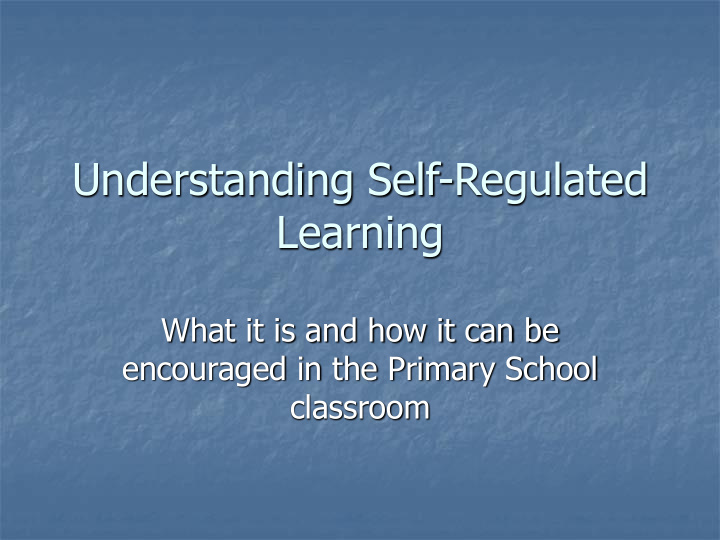



Understanding Self-Regulated Learning What it is and how it can be encouraged in the Primary School classroom
Pre-requisites for Self-Regulated Learning (SRL) Motivation Fulfilled lower order needs Goals – setting, monitoring, reflecting Positive self belief
Motivation Intrinsic motivation Pursuing a task for personal interest or curiosity, whether inherent or internalised (Woolfolk & Margetts, 2013, p. 353) Self determination theory Humans are inherently active [and] intrinsically motivated (Deci & Ryan, 2012, p. 3)
Maslow’s Hierarchy of Needs Students must have physiological and safety needs met before they will take further developmental risks (Woolfolk & Margetts, 2013, p. 357) Students will then strive to attain higher order needs Image: Heffner, 2002
SMART goals Specific Have clear instructions regarding expectations Measurable Show visible differences in quality or quantity Achievable Provide realistic challenges Relevant Make sense to student Time-framed Have realistic deadlines (adapted from Macquarie University, n.d.)
Beliefs about self Epistemological Believing learning is understanding Ability Believing ability is unstable and controllable Attribution Taking responsibility for results Efficacy Assessing competence for tasks Worth Comfortable taking risks Woolfolk & Margetts, 2013, pp. 364-6)
Self-Regulated Learning Cycle Identify and Regulate define task learning Set goals and devise plans With constant Implement metacognitive learning tactics monitoring, tasks and and strategies goals are redefined, tactics and strategies adapted and modified. Adapted from (Winne & Hadwin, 1998, pp. 282-5)
Characteristics of Self-Regulated Learners Approach tasks confidently and methodically Aware of skills, proactive in skills mastery Overcome obstacles to learning Take initiative and control (Zimmerman, 1990, p. 4, 13, 14) High self-efficacy (Woolfolk & Margetts, 2013, p. 368)
Supporting development of SRL Allow autonomy Involve students in social and learning decision making (setting class rules, following own inquiry path) (Woolfolk & Margetts, 2013, p. 384) Authentic learning experiences relate instruction to students’ personal experiences and expectations (Woolfolk & Margetts, 2013, p. 384) Progressive feedback Promote success and efficacy (Niemiec & Ryan, 2009, p. 139)
Developing emotional self regulation Teach coping strategies to build resilience (Woolfolk & Margetts, 2013, p. 160) Guide goal setting to small, achievable steps (Woolfolk & Margetts, 2013, p. 379) Maintain positive emotional relationship Variety Surprise Physical activity (Woolfolk & Margetts, 2013, p. 379) Reduce graded tests (evaluative pressure) (Niemiec & Ryan, 2009, p. 139)
Technology and SRL Fosters autonomy students make decisions about learning direction and pace (Gimbert & Cristol, 2004, p. 207) Increases attention span, persistence, independent exploration (Couse & Chen, 2010, p. 93) Provides swift progression feedback (Gimbert & Cristol, 2004, p. 208) Reduces requirement for direct supervision teachers can spend more time with every student (Talley, Lancy & Lee, 1997, p. 126)
Reference List Couse, L. J., & Chen, D. W. (2010). A tablet computer for young children? Exploring its viability for early childhood education. Journal of Research on Technology in Education, 43 (1), 75-98. E. L. Deci, & R. M. Ryan (eds). (2012). Self-Determination Theory. Handbook of Theories of Social Psychology: Volume 1. London: SAGE Publications Ltd. Gimbert, B., & Cristol, D. (2004). Teaching curriculum with technology: Enhancing children's technological competence during early childhood. Early Childhood Education Journal, 31 (3), 207-216. doi: 10.1023/B:ECEJ.0000012315.64687.ee Heffner, C. L. (2002). Personality synopsis: Chapter 10 - Humanistic Theory: Section 2 - Maslow's hierarchy of needs [Image]. http://allpsych.com Niemiec, C. P., & Ryan, R. M. (2009). Autonomy, competence, and relatedness in the classroom: Applying self-determination theory to educational practice. Theory and Research in Education, 7 (2), 133-144. doi: 10.1177/1477878509104318 Talley, S., Lancy, D. F., & Lee, T. R. (1997). Children, storybooks and computers. Reading Horizons, 38 (2), 116-128. Retrieved from http://scholarworks.wmich.edu/reading_horizons/vol38/iss2/4/ Winne, P.H., & Hadwin, A.F. (1998). Studying as self-regulated learning. In D. J. Hacker, J. Dunlosky & A. C. Graesser (Eds.), Metacognition in Educational Theory and Practice (pp. 277-304). New Jersey, USA: Lawrence Erlbaum Associates. Woolfolk, A., & Margetts, K. (2013). Educational psychology (3rd ed.). Frenchs Forest, Australia: Pearson Australia. Zimmerman, B. J. (1990). Self-Regulated Learning and Academic Achievement: An Overview. Educational Psychologist, 25 (1), 3-17. doi: 10.1207/s15326985ep2501_2
Recommend
More recommend